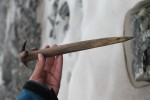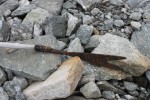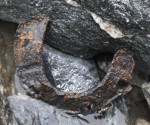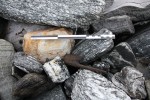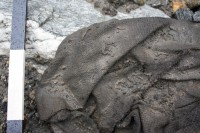 Archaeologists working on Norway’s Lendbreen glacier have found an intact woolen tunic dating to 300 A.D. The tunic is a greenish-brown now — it has darkened over the centuries — with a diamond pattern and it got a lot of use before it was discarded and swallowed up by glacial ice; there are several repaired patches. The garment was used as outerwear by a man about 5’9″ tall who for some mysterious reason took it off right next to a glacier 6,560 feet above sea level. One theory is that suffered from hypothermia which can make victims feel hot even in the middle of a freezing blizzard. Victims of hypothermia have been known to take off their clothes under the delusion that they’re hot.
Archaeologists working on Norway’s Lendbreen glacier have found an intact woolen tunic dating to 300 A.D. The tunic is a greenish-brown now — it has darkened over the centuries — with a diamond pattern and it got a lot of use before it was discarded and swallowed up by glacial ice; there are several repaired patches. The garment was used as outerwear by a man about 5’9″ tall who for some mysterious reason took it off right next to a glacier 6,560 feet above sea level. One theory is that suffered from hypothermia which can make victims feel hot even in the middle of a freezing blizzard. Victims of hypothermia have been known to take off their clothes under the delusion that they’re hot.
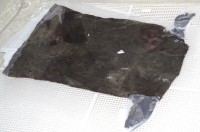 The age of the tunic was confirmed by radiocarbon dating and archaeologists believe it was left along a Roman-era trade route which stopped being used in the 4th century when the area iced over. Warming global temperatures are melting the glacier at an alarming rate, thus exposing ancient artifacts that have been trapped in ice for centuries. And so environmental disaster yet again proves itself to be a boon for archaeology, but the window for recovery of organic artifacts is very short. As soon as they are exposed to air they begin to decay, and since they’re being exposed by runoff, they go from the preserving embrace of ice to the rotting chokehold of water. Wood can take a few years to rot, but ancient textiles can be destroyed by insects and bacteria in a matter of weeks.
The age of the tunic was confirmed by radiocarbon dating and archaeologists believe it was left along a Roman-era trade route which stopped being used in the 4th century when the area iced over. Warming global temperatures are melting the glacier at an alarming rate, thus exposing ancient artifacts that have been trapped in ice for centuries. And so environmental disaster yet again proves itself to be a boon for archaeology, but the window for recovery of organic artifacts is very short. As soon as they are exposed to air they begin to decay, and since they’re being exposed by runoff, they go from the preserving embrace of ice to the rotting chokehold of water. Wood can take a few years to rot, but ancient textiles can be destroyed by insects and bacteria in a matter of weeks.
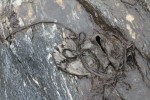 The tunic was found in 2011, but archaeologists have been exploring the glacier since 2006. They have discovered more than 1,600 ancient artifacts exposed by melting ice since then, including wooden weapons, tools and textiles. They range from a 3,000-year-old leather shoe to the remains of a 1000-year-old base camp thought to have been used by reindeer hunters. The hunters set
The tunic was found in 2011, but archaeologists have been exploring the glacier since 2006. They have discovered more than 1,600 ancient artifacts exposed by melting ice since then, including wooden weapons, tools and textiles. They range from a 3,000-year-old leather shoe to the remains of a 1000-year-old base camp thought to have been used by reindeer hunters. The hunters set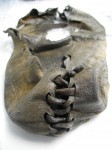 up tents on the top edge of the glacier and used the snowdrifts to trap the animals which would then be dispatched. The meat was probably processed on site and transported back to populated areas.
up tents on the top edge of the glacier and used the snowdrifts to trap the animals which would then be dispatched. The meat was probably processed on site and transported back to populated areas.
A remarkable collection of objects testify to this operation: a wooden tent peg, textiles, spear tips, arrows with ingenious split designs or tipped with embedded shell to harden and sharpen the point, a horse shoe, even a complete set of scare sticks, wooden planks tied together to make a lot of noise when shaken. The 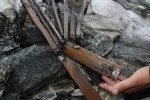 reindeer would be chased into the snowdrift traps by the sound of the scare sticks. There are artifacts that are unknown to us today whose use is a mystery.
reindeer would be chased into the snowdrift traps by the sound of the scare sticks. There are artifacts that are unknown to us today whose use is a mystery.
There’s an excellent photo gallery of the more recent Lendbreen finds here and one of some of the older discoveries here.
